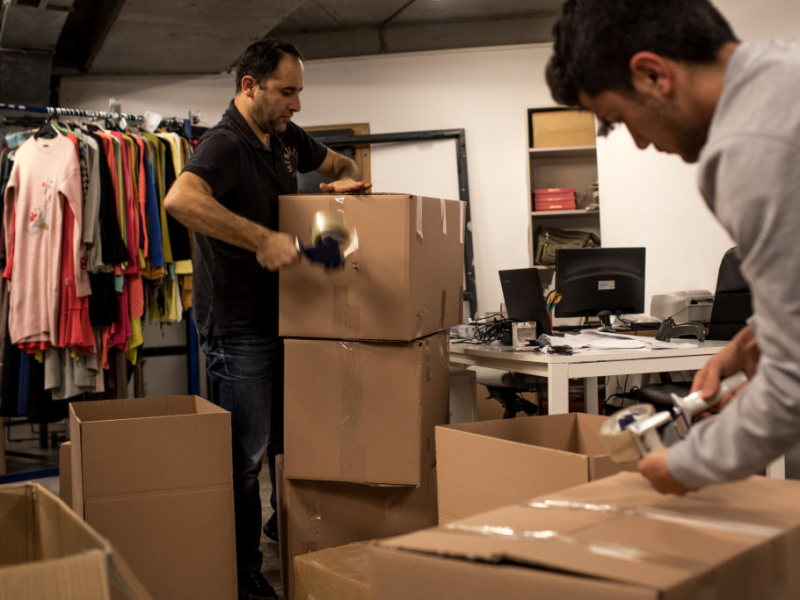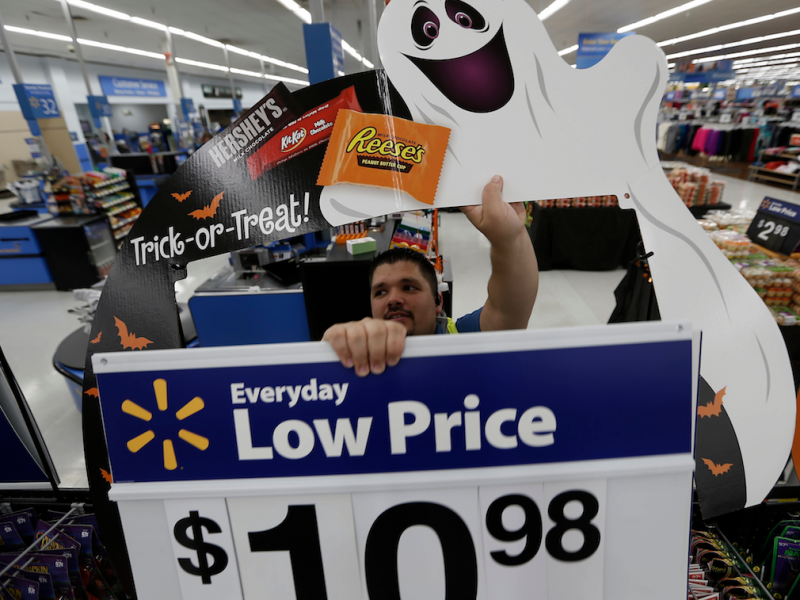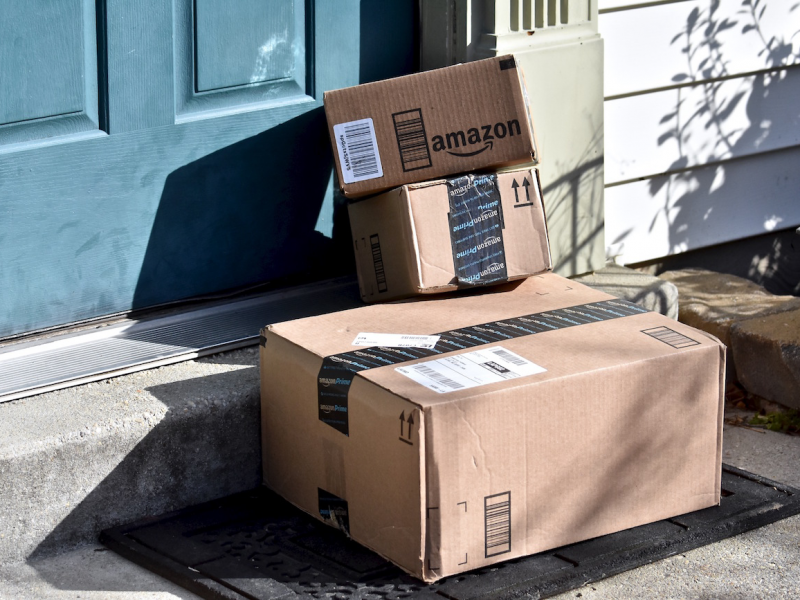- A new report has found that five major online retailers – includingAmazon, Walmart, and eBay – sold fake products that can be harmful to your health.
- Of the 47 products investigators bought, which ranged from Nike Air Jordan shoes to Urban Decay makeup, 20 were counterfeit.
- Looking for a few red flags will help you protect yourself from purchasing a fake product.
Next time you’re about to purchase an item from your favorite online retailer, you might want to do a double take.
A recent report from the Government Accountability Office revealed that products purchased from third-party sellers on five major e-commerce sites could be counterfeit – and harmful to your health.
Out of the 47 products – all Nike Air Jordan shoes, Yeti travel mugs, Urban Decay makeup, and UL-certified phone chargers – investigators bought from Amazon, Walmart, eBay, Sears Marketplace, and Newegg, 20 were counterfeit.
All of the shoes were authentic, and only one UL-certified phone charger was fake, but it was a whole different ballpark with the other two categories – six of nine Yeti travel mugs and all Urban Decay makeup were fake.
It's unknown which products came from which retailer, but it is known that one counterfeit item and one authentic item was purchased from each site.
Not only are consumers being duped, they're being exposed to potentially dangerous materials. The report claimed that counterfeit iPhone adapters can pose a risk of lethal electrocution, counterfeit travel mugs can include higher lead concentrations, and counterfeit cosmetics contain substances such as cyanide, mercury, and rat droppings.
Those aren't things you want in your hands or on your face.
What's doubly concerning is that it's hard to discern the difference between what's fake and what's real. The items, all shipped from the US, were advertised as new and name-brand and were sold by third-party sellers with average customer ratings above 90% - all factors that instill a higher sense of confidence and trust in the buyer.
It's also hard identify what's fake knowing that all five companies have strict protocols and a "zero tolerance" policy for counterfeit products that involves removing said goods from their marketplaces, which they confirmed to CBS News.
Yet, somehow the counterfeits persist. "Counterfeit is an age-old problem, but one that we will continue to fight and innovate on to protect customers, brands, and sellers," an Amazon spokesperson said in a statement to Business Insider (see below for the full statement).
Counterfeit goods account for almost 10% of worldwide trade, according to the World Customs Organization.
"I'm not telling anyone to not purchase anything online anymore, that would be unreasonable, but certainly you can look for various things that would help guard you against getting something that's counterfeit," Kimberly Gianopoulos, director in international affairs and trade groups at GAO, told Circa News.
Keep reading for seven tips for to help you avoid buying fake products online.
1. Know who's selling the product

Third-party sellers often use sites like Amazon to clear their excess inventory, garner more visibility, or find a larger audience. While these sellers don't equate to a fake product, they do warrant a closer look as most counterfeit products come from them.
AHow-to Geekwriter, who was scammed by a counterfeiter on Amazon, breaks down three different types of products you'll find on the site:
Ships from and sold by [Name of Third-Party Seller]:The product is sold by the third-party seller and shipped directly to you.
Sold by [Name of Third-Party Seller] and Fulfilled by Amazon:A third-party seller ships the product to Amazon's warehouses, which then ships it to you without confirming the product is authentic beforehand.
Ships from and sold by Amazon.com:Amazon sells the product, so it should be legitimate. While this method isn't completely immune to counterfeits, as they can get commingled into the general stock, it's still your best bet.
Narrow down your shopping search on e-commerce retailers to products sold by the site itself.
2. If it's not coming from the retailer, look up the seller

"You can look to see if something is sold by or fulfilled by that particular website. If it's fulfilled by that, [it] doesn't mean that website is selling it to you, it means that they are getting the product to you, but it's coming from a third party," Gianopoulos said, adding you should look for a customer service phone number and address in case you need to return the product.
Find the seller via the website's product page, check out their profile, and even Google them - a lack of online presence is worth noting.
Michael Crider ofHow-To Geekcautions against a "just launched" badge on a seller's profile, as scammers often run multiple accounts for short periods of time - and against odd names. In an attempt to slip through counterfeit defenses, scammers will use random groups of characters for their name.
"If the name of the vendor is something that looks like it was typed by a drunk monkey, it's probably fake," he writes.
3. Spot the fake reviews

Sometimes, the telltale sign of a fake a product is a fake review. Just because an item has five-star ratings doesn't mean it's authentic. On the contrary, a high number of positive reviews can be a red flag.
Don't be fooled by a "verified purchased" tag on Amazon - while it helps establish credibility, sellers cheat the systemby hiring businesses to create dummy accounts, purchase products, and write a stellar review.
You can use online tools to help determine the legitimacy of a review, such asFakespot, which provides a score regarding the likelihood of fake reviews for a product.
But, you don't always need the help of an online service - there are a few warning signs you can spot with your own eye.
Wirecutterpoints out that a lot of positive reviews within a few days can indicate people pushed for reviews to happen on a timeline. Poor spelling and grammar, similarly staged user photos, and similar wording can also be warning signs, as cancertain words and phrases- think high usage of first-person singular, verbs, and adverbs as well as specifics, like references to people or exact details.
4. Look into shipping logistics

Another red flag waves in the form ofextra-long ship times, especially on Amazon where third-party sellers don't see their sales in their bank accounts for fourteen days.
A new vendor with fake merchandise has to maintain their account for at least two weeks, so they'll schedule shipping time for longer than the Amazon processing time to prevent consumer complaints.
Also look from where the product is shipping. "I don't want to pick on China, but that's where most of the counterfeits are coming from," James Thomson, a former Amazon executive, told MarketWatch.
5. Examine product photos

In the age of Photoshop and technology, it's easy for a scammer to edit or steal a photo to make their product look authentic.
Stuart Fuller, director of commercial operation and communications at global brand protection firm NetNames,recommends downloading an imageand using Google's reverse image search to see if the photos were taken from another site.
He also suggests contacting the seller to ask for more photos. If they won't provide their own photos, there's probably a reason behind that.
6. Watch out for unrealistic deals

Ryan Robison of detective agency the Robison Group toldMarketWatchthat the biggest telltale sign of a counterfeit item is the price.
"Almost always, the incentive for people to buy [suspect goods] is that they're cheaper," Thomson explained. "But the reason they're cheaper is because they haven't been tested and certified."
In an interview withNewBeauty, Kelly McCarthy, partner at intellectual property and brand protection group Sideman & Bancroft, advised avoiding the temptation to purchase beauty products from convenient online locations - instead, buy them directly from the brand or department store.
"If you see a 'deal' on beauty products and the sale is not happening in a store that you know is an authorized seller, you are definitely raising your risk that the product is fake," she said. "If the pricing looks too good to be true, it probably is."
7. Inspect the product for suspect packaging

If you've done all the above and decided the product should reach your doorstep, your inspection shouldn't stop there.
goVerify on eBayhas a few guidelines on what to look for when determining the authenticity of a designer item, as do YouTube videoscomparing dupes with their legitimate counterparts.
There are a few general tricks you can look for - tags, typos, misspellings, and poor printing should allbe on your radar. Packaging should include all the retail packaging for new products, such as manuals or printed materials, and UPC barcodes.
Bharat Dube, chief executive of brand protection agency Strategic IP information, told MarketWatchsuspect packaging "can be basic things such as not having plastic covering on the hand bag's handle."
If something looks off, return it and contact customer service to seek a refund.
An Amazon spokesperson provided the following statement to Business Insider concerning the sale of counterfeit goods on its site:
"Our customers trust that when they make a purchase through Amazon's store-either directly from Amazon or from one of its millions of third-party sellers-they will receive authentic products, and we take any claims that endanger that trust seriously. We strictly prohibit the sale of counterfeit products and invest heavily-both funds and company energy-to ensure our policy against the sale of such products is followed. Our global team is available 24 hours a day, 7 days a week to respond to and take action on reported violations and notices of potential infringement.
"In order to detect bad actors and potentially counterfeit products, we make significant investments in machine learning and automated systems. We employ dedicated teams of software engineers, research scientists, program managers, and investigators to operate and continually refine our anti-counterfeiting program. When a business registers to sell products through Amazon's Marketplace, Amazon's systems scan information for signals that the business might be a bad actor, and Amazon blocks identified bad actors before they can offer any products for sale. Amazon's systems also automatically and continuously scan numerous data points related to sellers, products, brands, and offers to detect activity that indicates products offered might be counterfeit. Over 99.9% of all Amazon page views by our customers landed on pages that did not receive a notice of potential infringement.
"We also work closely with vendors, sellers, and rights owners to strengthen protections for their brands on Amazon. Any rights owner can enroll in Amazon's Brand Registry to manage and protect their brand and intellectual property rights on our store. More than 40,000 brands are enrolled in Brand Registry and are using our free service to better protect their brand and control product information displayed on Amazon-this means brands can ensure their information is accurate and customers can make confident, informed purchasing decisions on Amazon.
"We encourage rights owners who have product authenticity concerns to notify us; we investigate all claims thoroughly. We remove suspected counterfeit items as we become aware of them, and we permanently remove bad actors from selling on Amazon. Amazon investigated and took action on 93% of all notices of potential infringement received from Brand Registry within four hours. With our proactive innovations that learn from the information in Brand Registry, brands in Brand Registry on average are finding and reporting 99% fewer suspected infringements than before the launch of Brand Registry. We have also successfully taken legal action against bad actors and will continue to pursue litigation and work with law enforcement where appropriate.
"Customers are always protected by our A-to-z Guarantee, whether they make a purchase from Amazon or a third-party seller. If the product doesn't arrive or isn't as advertised, customers can contact our customer support for a full refund of their order.
Customers trust that they will receive authentic goods when they shop on Amazon and anything that diminishes that trust is unacceptable. Counterfeit is an age-old problem, but one that we will continue to fight and innovate on to protect customers, brands, and sellers."

